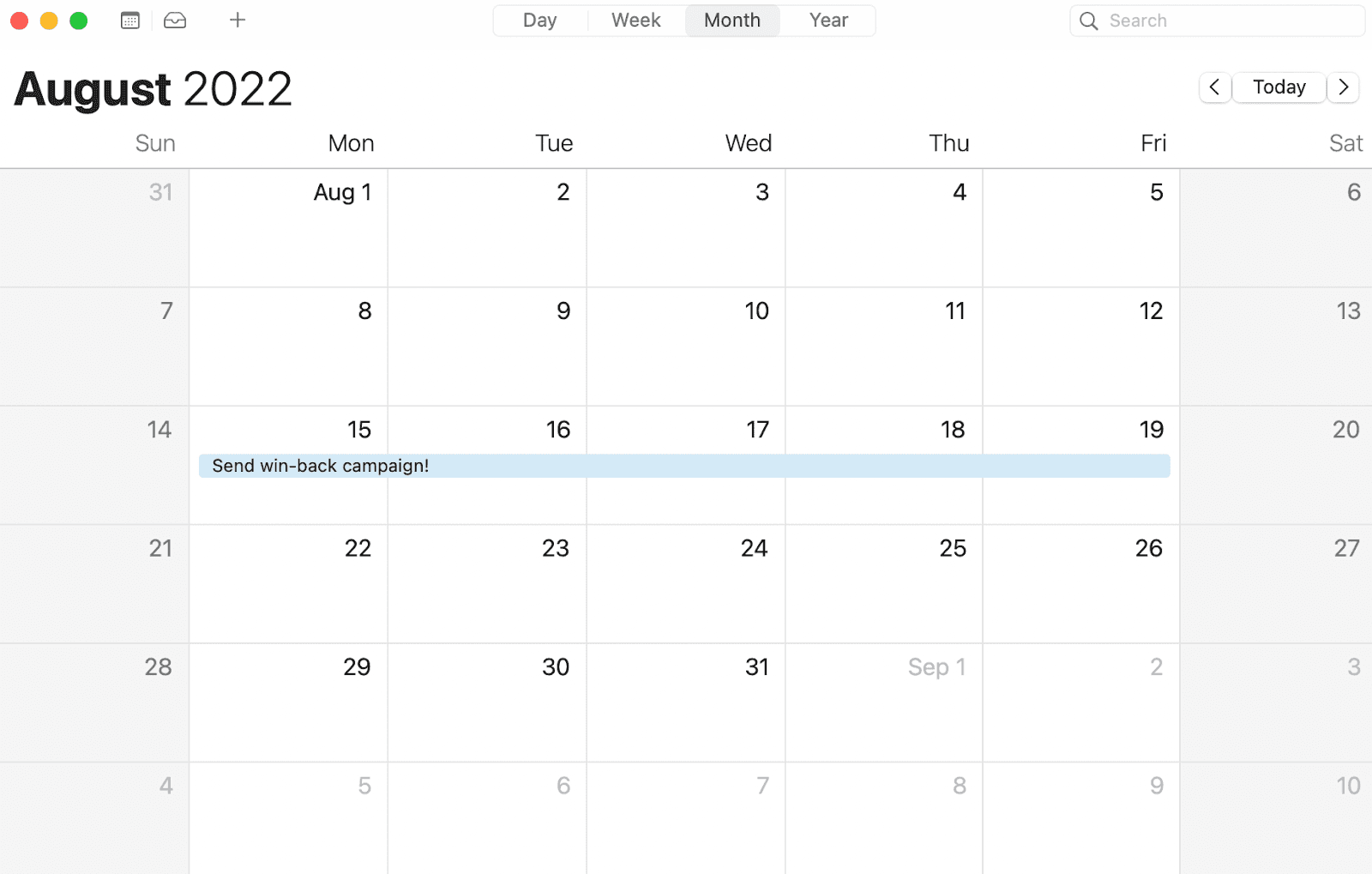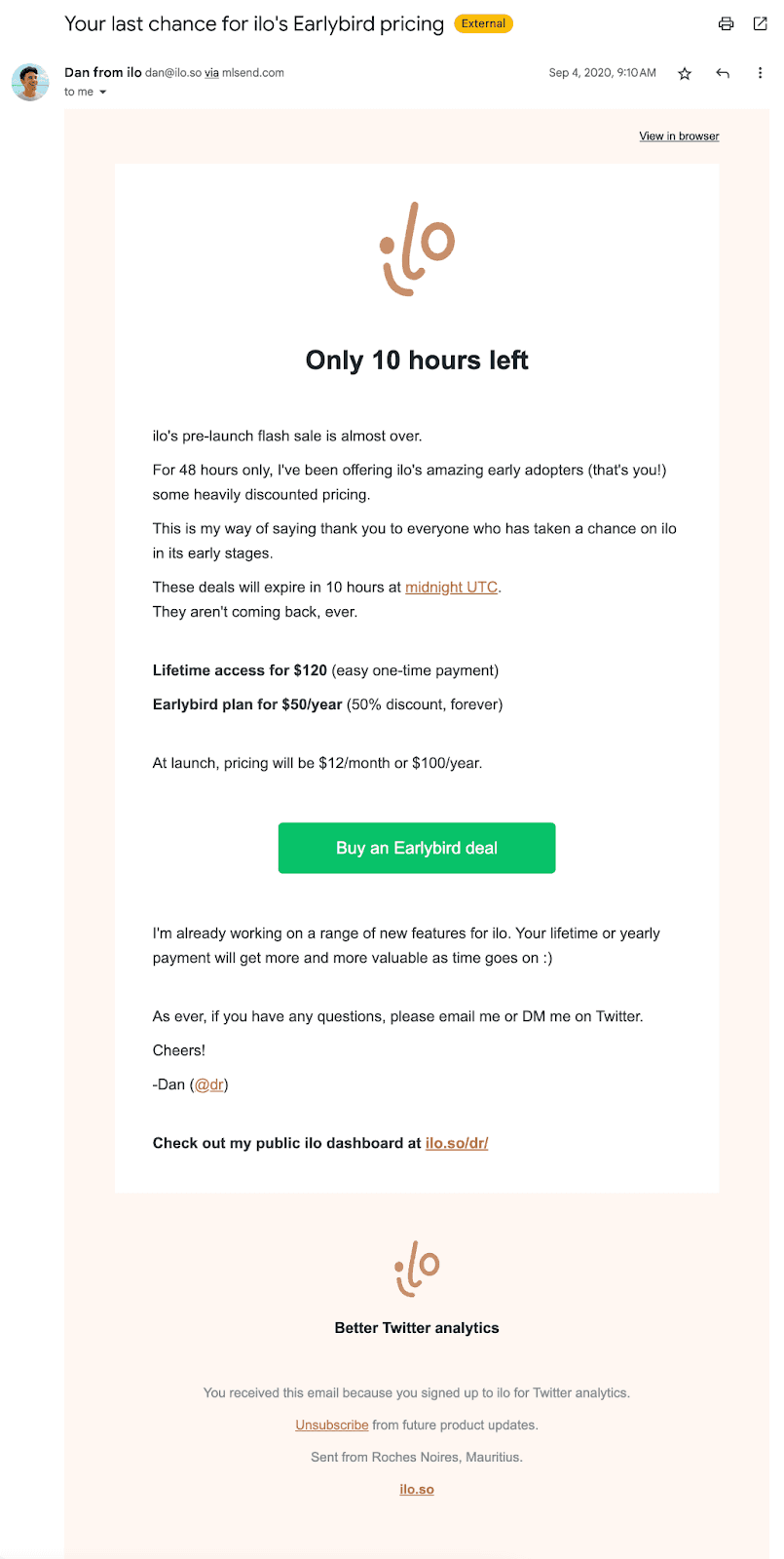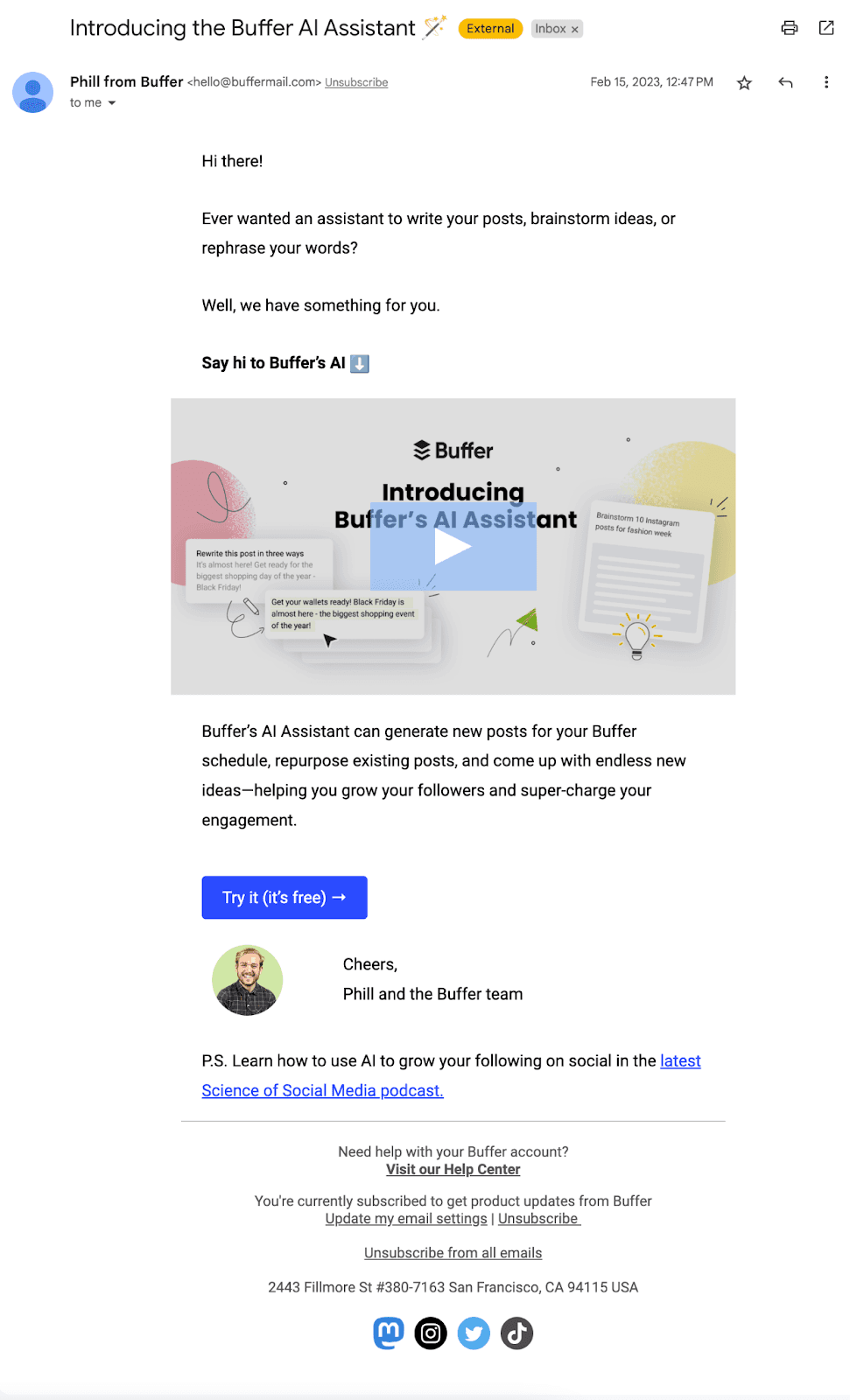Using Win-Back Campaigns to Retain Customers (Ideas and Examples)
May 30, 2021
You worked so hard to acquire your customer, spending both significant amounts of time and money. Your marketing copy was enticing, your sales team was knowledgeable, your customer success team was more than helpful… but your customer still went radio silent.
This happens and it’s completely normal.
It doesn’t have to be the end if a user cancels.
As you probably know, retaining customers for your SaaS business is just as important as acquiring new ones [link back to big SaaS guide here]. That's where a win-back campaign comes in!
By targeting customers who have previously signed up for your product or purchased from you but have since gone inactive, a win-back email campaign can reignite their interest, drive repeat purchases, and even win back their loyalty.
Below we’re going to explore why a win-back campaign is an essential component of your email marketing strategy and share some ideas and examples to help you craft a winning campaign that delivers results.
Let’s win-back those inactive customers.
What is a win-back campaign
A win-back campaign, also known as a customer reactivation campaign, is a marketing strategy aimed at re-engaging customers who have previously purchased from a company but have not made any recent purchases or have stopped engaging with the company.
The goal of a win-back campaign is to encourage these customers to make a purchase or resume an active relationship with your company.
Win-back campaigns typically involve targeted messaging and incentives or deals to encourage customers to return, but really it’s about reminding users why they signed up in the first place. After all, at some point they decided to sign up to use your service. If they churned since then or dropped off in engagement, it’s likely an opportunity for you to improve.
That’s where win-back campaigns come in. They are a simple way to reignite a relationship with a user. They’re also super effective!
In fact, a recent study shows that 45% of recipients who receive your win-back campaign will actually go on to engage with future communications from you which is definitely better than a user outright churning.
When should I send a win-back campaign
There is no one-size-fits all for when a company should send a win-back email campaign. The exact timing and messaging of your win-back campaign will heavily depend on your customer lifecycle and the product or service that you are selling.
For example, if you’re running a SaaS business, a potential inactive customer might be someone who hasn’t logged in to their account for a certain number of weeks.
With that in mind, it is common practice to begin sending win-back email campaigns to customers who have not engaged with your product or company for 2-3 weeks — but you can start even earlier if it makes sense to your company’s metrics. For example, if a user is on a free trial that is ending soon but they seem to have stopped engaging, reach out and see if there is anything that you can help them with.
You will want to judge the period of time based against top-performing users and optimize against that baseline.
As you let more and more time pass, a customer is less likely to re-engage with your brand and future communications.

This timeline is typically long enough that you can somewhat safely assume that a customer has either forgotten about you or stopped caring about your product in a way that a loyal customer would.
But again, the specific timeline may vary business to business. It’s crucial that you use a timeline that is in line with the typical lifecycle and usage of your customers.
This is the perfect time to provide an incentive to win them back. It’s important to lure these inactive customers back before they fully churn or unsubscribe — cutting off all future communication opportunities.
Win-back campaign ideas and best practices
You should be starting to see the importance of win-back campaigns for your SaaS business. Maybe you’ve already decided to implement them into your email marketing strategy. But how?
Here are some win-back campaign ideas and best practices to help you send successful campaigns:
Personalize your emails: Personalization can go a long way in making customers feel valued and understood. Use their first name, reference past usage, and tailor the email to their specific interests and needs (or ask them what those are if you don’t already know!)
Offer incentives: Offer customers an incentive to return, such as a discount or extended free trial. This just might give them the push they need to come back and buy from you again.
Highlight new products or services: If you've released new products or services since the customer's last purchase and think they might benefit from them, let them know. This can encourage them to come back and see what's new.
Create a sense of urgency: Use language that creates a sense of urgency, such as a limited-time offer or a deadline for the incentive. This can motivate customers to act quickly and make a purchase.
Test different subject lines and send times: Experiment with different subject lines and send times to see what resonates with your customers. Use A/B testing to compare the performance of different emails and optimize your win-back campaign over time.
Keep it simple: Keep your win-back email simple and easy to understand. Make the call-to-action clear and prominent and avoid overwhelming customers with too much information.
Segment your audience: Segment your audience based on their behavior and engagement level. For example, you may want to send different win-back emails to customers who have been inactive for three weeks versus those who have been inactive for 3 months.
Overall, a successful win-back campaign requires a combination of personalized messaging, incentives, and strategic timing.
By following these best practices, you increase the likelihood of successfully re-engaging your inactive customers and driving additional sales and revenue for your business.
Win-back campaign subject lines
We mentioned testing different subject lines above. This is an important step of sending a successful win-back campaign.
You’re fighting an uphill battle.
Your customer or user has already shown that they are losing interest in your product or service. Writing an effective email subject line that is both captivating and worth clicking on can make or break your campaign.
Subject lines can have a handful of different approaches.
Incentive. Sense of urgency. Feedback. Emotional. Product updates. Just to name a few. You will see some of these approaches below.
Here are some subject line suggestions to kickstart your win-back campaign:
We Miss You! [Name]
Last chance to [Action] and receive [Incentive]!
It's been a while, [Name]! Here's a [Discount] to welcome you back
Are you still interested in [Product/Service]? Here's [Incentive] to come back
[Name], we have a surprise for you!
We want you back! [Discount] to get you started
[Name], don't leave us! Here's [Incentive] to stay
Give us a second chance, [Name]. [Discount] inside!
[Name], we noticed you haven't shopped with us in a while. Here's [Incentive] to return
A very special offer for our valued customers like you, [Name]
Remember to keep your subject line short, personalized, and attention-grabbing.
By using these examples as inspiration, you should be well on your way to create an effective subject line for your win-back email campaign that encourages recipients to open and engage with your message and company again.
Setting up your win-back campaign for success
Crafting a successful win-back campaign will require you to truly understand your audience and users.
Following the above best practices and subject line suggestions will only go so far. If you do not understand your audience on a deep level, your communications and incentives will seem impersonal and inauthentic.
To ensure your win-back email campaign is successful, all of the best practices above need to work in harmony.
Personalization 🤝 Relevant copy 🤝 Attractive incentives

Measuring win-back campaign results
It is essential that you measure the results of your win-back campaigns. Otherwise, you are essentially just guessing as to whether your efforts are truly paying off or not.
The easiest way to measure success is to track the open rate (OR) and click-through rate (CTR) of your win-back emails. These metrics will give you an easy snapshot of the level of engagement your emails are receiving.
If your campaign’s call to action is aligned with your product goals, this click-through rate should correlate to the overall success of your campaign.
For example, if your goal was to increase activity from a user of your SaaS product, you should be able to track actions that they have taken in your product after engaging with the email. Maybe you’re hoping an inactive user on a free trial will engage with your product again and upgrade to a paid account. A well crafted win-back campaign would be easy to measure the true results.
Much like any other email campaign, there is no such thing as a perfect win-back email.

You should plan to constantly analyze results in order to identify areas for improvement. Use this data to optimize future win-back campaigns so that you can re-engage with more customers and increase sales and revenue in the process.
Win-back campaign examples proven to retain customers and increase profits
Let’s take a look at some examples of win-back campaigns that have successfully been used in the wild.
Offer special incentives
In this win-back email, ilo is offering a special early bird discount for beta testing the product. They are hoping this discount as well as appreciative messaging will prompt me to upgrade to a paid account at a heavy discount.

Highlight new product
In this win-back email, Buffer is informing me of their new AI Assistant feature . They are hoping that this new feature that leverages the hot trend in tech will entice me to check it out.

Create a sense of urgency
Namecheap is creating a sense of urgency in this win-back email by letting me know that I have 30 days to renew my domain or risk losing it forever. They are hoping that this deadline will prompt me to login and extend my domain instead of letting it lapse and hit the open market.

Set it and forget it?
While in some cases one win-back email might be enough to bring back an inactive customer, that will not always be the case.
If an inactive customer is still not engaging after one or two messages, you may need to send another!
As long as the customer hasn’t fully churned or unsubscribed, you are still able to send them messages in an attempt to win them back.
Take Namecheap for example. If you have an expiring domain, they make sure to let you know… repeatedly.

And guess what? It worked. I renewed the domain.
One message won’t always be enough. Life happens. Additional messages may be needed to catch your customer at just the right time when they’re ready to take action.
Win-back inactive customers and increase revenue
Don’t let those hard earned customers fade away without putting up a fight. They were a customer of yours for a reason — now is the time to remind them of why.
By offering incentives, personalization, and relevant messaging, win-back email campaigns can create a sense of urgency and persuade customers to take immediate action.
Additionally, these campaigns can help you learn more about your customers' needs and preferences, which can inform your future marketing strategies.
In today's competitive market, businesses cannot afford to lose customers. Win-back email campaigns are a cost-effective and efficient way to keep them coming back.
So, if you haven't already, it's time to start implementing win-back email campaigns and reap all of the benefits (and revenue) that they have to offer.
Win-back your customers with Loops
You worked hard for your customers. Let us help you keep them.
Join thousands of others and send that timely win-back campaign with Loops.